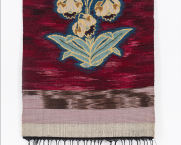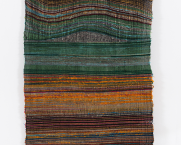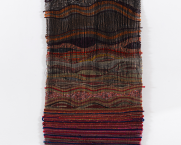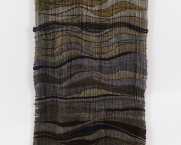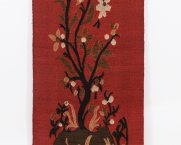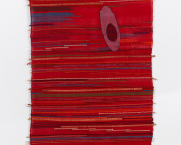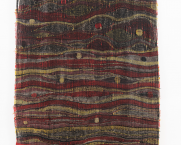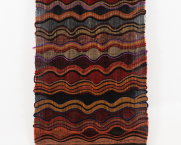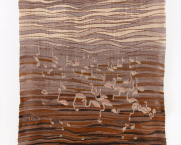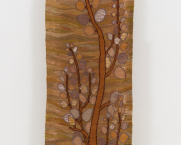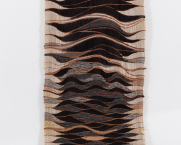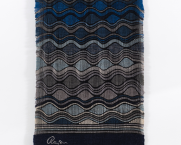C&L Shows
RAJEN (1931 – 2021): A Weaver of Magic
Rajen
2024
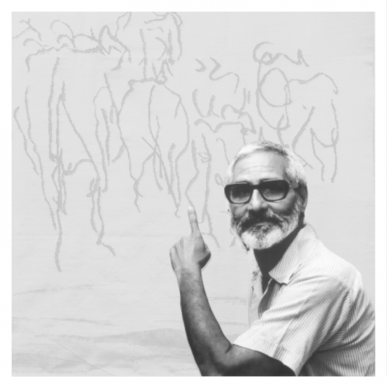
Overview
Rajen Chaudhari
Artist, Weaver.
February 24, 1931 to March 16, 2021
A colourful journey
Rajendra Chaudhari, simply known as Rajen to most, and Baba to those who were close to him, passed away on March 16, 2021, at the age of 90, leaving behind a rich tapestry of imprints from his long and prolific career, spanning over 60 years. Rajen was an artist. The medium he chose to paint in though, was unique. Artist Rajen wove. He used a humble weaver’s loom as his paint brush, weaving his magic into the loom, capturing and captivating a generation’s imagination with a sweep of his brush and the throw of his shuttle.
Pastoral Beginnings
Rajen was born into a well-to-do farming family in Sahranpur, North India. Hard working, rooted to the soil, Rajen’s family had no involvement with the arts except for some folk music sung on special occasions. Yet, from early on, art and music flowed from Rajen’s heart.
At age nine, Rajen was sent to a Gurukul for schooling. For Rajen, those were some of his most enriching years. As he would narrate, “All students spun on a charkha every day for at least 40 minutes, and it became a ritual that we enjoyed very much. We also used to learn music; it was a beautiful time in life.” Nostalgically he would continue
“I used to win the spinning competition; it used to be called the Charkha Dangal.” Spinning the charkha, conversing in Sanskrit, learning music, wrestling, swimming in the Ganges — this all-encompassing way of living and learning were pivotal in shaping Rajen.
Rajen completed his class 10 studies at Gurukul Kangri and then graduated with a B.A. from Agra University. But Rajen’s heart was in the fine arts. On the suggestion of a close family friend he join the Sir J. J. School of Arts in Bombay to study painting. These were the mid 1950s and India was just emerging as a nation independent from colonial rule. The burgeoning art scene in Bombay was abuzz with intellectual and critical fervour; with the contemporary and the modern brushing imaginations with the traditional, folk and cultural- reflecting the everyday pluralism of life that is India. It is against this backdrop that Rajen began his artistic training.
As Rajen would later narrate to his daughter “We artists would read novels of old masters and try to imbibe their lifestyle- going to the railway station, staying up all night there and sketching, sketching, sketching”. Human anatomy and gestures were considered one of the most important to master and there would be studio sessions with nude models at the art school. But as Rajen would laughingly lament, “oh, they were often old!” Yet, it is this vigorous engagement in art school days that gave Rajen his unmistaken skill and command.
A gazetted officer at Almora
Soon after he completed art school, Rajen found a job as an artist-designer with the Uttar Pradesh State government’s ‘Hill Wool’ Scheme. Here, Rajen decided to learn the fundamentals of weaving. He joined the Weavers’ Service Centre in Banaras, and under the guidance of Mr. A.K. Das mastered the grammar of weaving. Thus began a journey that changed the way Rajen engaged with art.
The joy of teaching
At Almora, Rajen heard about a new design institute starting in Ahmedabad, the now world-renowned National Institute of Design (NID). Rajen applied for a teaching position at NID and was accepted. Later at NID, Rajen received a one year Ford foundation scholarship to study textile design at the Royal College of Arts, U.K., the Arts School of Helsinki, Finland, and the Konstfack Skolam, Stockholm, Sweden. These exchanges foundationally transformed Rajen’s understanding of textile craft, changing the way he looked at the art and design of woven textiles.
Just before leaving for Europe, Rajen had met Darshini Shah, a young classical dancer at the Darpana Academy of Performing Arts in Ahmedabad. Darshini’s quiet grace captivated Rajen and a special bond blossomed between the two. On Rajen’s return from Europe, the two got married with the blessings of their parents. Soon after marriage, with the support of his father-in-law, Rajen started his own studio, calling it the ‘WeaveLab’. He quit NID as full time faculty, so as to be able to pursue his own artistic callings.
Art at heart
The ‘WeaveLab’ is where Rajen explored his passion for painting, weaving his magic into the conversations between warp and weft. Experimenting with the multitudes of weaves in his repertoire, Rajen’s WeaveLab grew to be a treasure trove of textiles. From tapestries to pile rugs, lino screens, double-cloth weaves, Gobelin wall-hangings, triple layered dhurries, warp-based fabrics, weft-based furnishings… Rajen’s technical prowess was extensive, as was the thrill of the designs that came off his loom. Rajen’s fine structural understanding of the various weaving techniques from across the world allowed him to experiment freely, sometimes mixing weaves from east and west, sometimes inserting found materials like feathers, cassette tapes or even chips of clay tiles into his weaves. “My loom broke twice, but I finished it,” he had once shared in an interview. Undaunted by challenges of size, scale or material, Rajen created some monumentally large tapestry curtains (60 ft × 30 ft), specially designed for auditoriums in Ahmedabad.
Distinct but without a need to adhere to a monadic stylistic language, Rajen unabashedly wove into his art the multitudes of cultures and times that marked his horizon. His subjects could vary from nudes to the divine, Kalamkari motifs to abstract compositions, or calligraphy with profound meaning to innocent frolicking animals. Whether it was a spontaneous splash of a moments brush with time, or a play with lores past that found their way into his present- Rajen’s art carried the joy of the moment.
Well known among the creative circles and one among the prominent architects, interior designers, and musicians of the time, Rajen was a force to reckon with in the field of textile and tapestry art. Rajen’s work has been exhibited across major cities in India and abroad, including Delhi, Mumbai, Bengaluru, Chennai, Vadodara, Kolkata, as also overseas, in Brussels, Belgium, Denmark, Japan, U.K and U.S.A. His patrons too are spread across the globe, spanning an impressive spectrum of public institutions, professionals, and private collectors. His tapestries today adorn numerous walls across the globe. Compellingly, they speak of a thread that connects all humanity.
The fabric of life
With an infectious smile and a zest for life, Rajen continued to weave till the very last. In his last few years, Rajen suffered from Alzheimer’s, but while his memory failed, he continued to weave. As his daughter Fakira tells us “He was more right-brained than left-brained, so, the artistic side of him was fine.”
Rajen’s intense and vigorous practice left a deep imprint on all who witnessed it. His surprising sensibility of colours and innate spontaneity lent a rare richness, originality and verve to his art. He would often say that he could paint 20 paintings in a day, which in spirit he could… while spinning, weaving, dyeing, singing… one joyously flowing into the other.
Today, Rajen’s legacy is being carried forward by his daughter Fakira with the help of the women at WeaveLab.
~ Jaai Kakani
Rajen (1931 – 2021) A Weaver of Magic | Digital Catalogue
A video walkthrough by Mortimer Chatterjee

